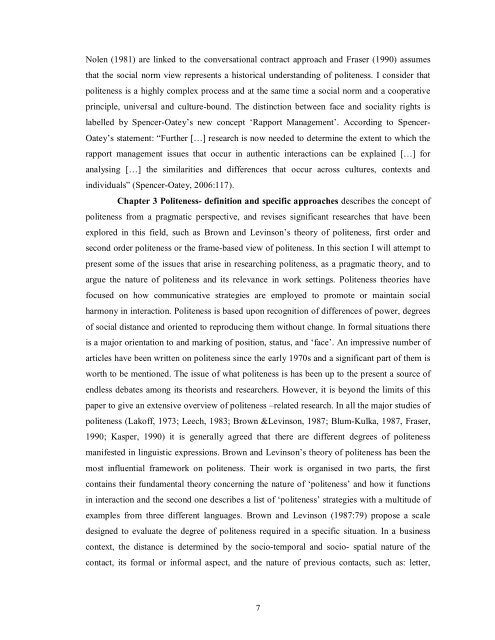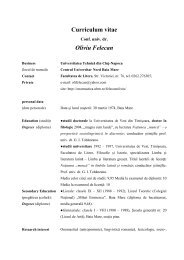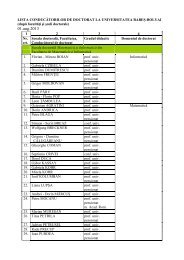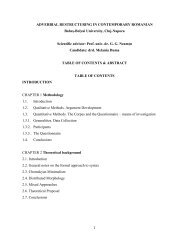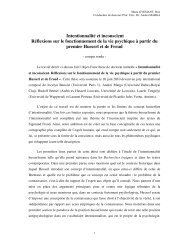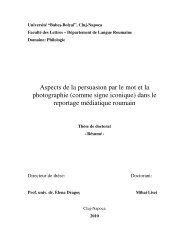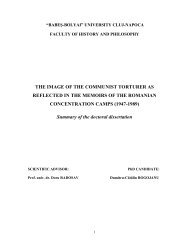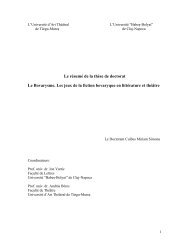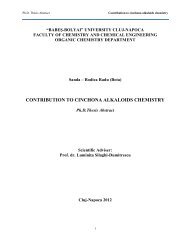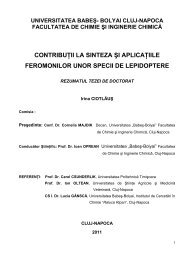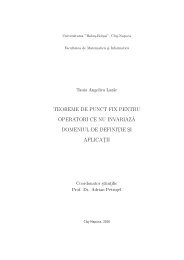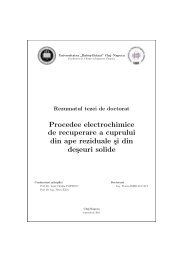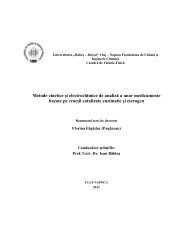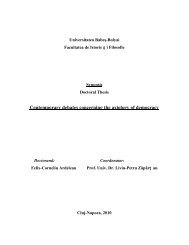1 UNIVERSITATEA “BABES –BOLYAI” CLUJ-NAPOCA ...
1 UNIVERSITATEA “BABES –BOLYAI” CLUJ-NAPOCA ...
1 UNIVERSITATEA “BABES –BOLYAI” CLUJ-NAPOCA ...
You also want an ePaper? Increase the reach of your titles
YUMPU automatically turns print PDFs into web optimized ePapers that Google loves.
Nolen (1981) are linked to the conversational contract approach and Fraser (1990) assumes<br />
that the social norm view represents a historical understanding of politeness. I consider that<br />
politeness is a highly complex process and at the same time a social norm and a cooperative<br />
principle, universal and culture-bound. The distinction between face and sociality rights is<br />
labelled by Spencer-Oateys new concept Rapport Management. According to Spencer-<br />
Oateys statement: Further [ ] research is now needed to determine the extent to which the<br />
rapport management issues that occur in authentic interactions can be explained [ ] for<br />
analysing [ ] the similarities and differences that occur across cultures, contexts and<br />
individuals (Spencer-Oatey, 2006:117).<br />
Chapter 3 Politeness- definition and specific approaches describes the concept of<br />
politeness from a pragmatic perspective, and revises significant researches that have been<br />
explored in this field, such as Brown and Levinsons theory of politeness, first order and<br />
second order politeness or the frame-based view of politeness. In this section I will attempt to<br />
present some of the issues that arise in researching politeness, as a pragmatic theory, and to<br />
argue the nature of politeness and its relevance in work settings. Politeness theories have<br />
focused on how communicative strategies are employed to promote or maintain social<br />
harmony in interaction. Politeness is based upon recognition of differences of power, degrees<br />
of social distance and oriented to reproducing them without change. In formal situations there<br />
is a major orientation to and marking of position, status, and face. An impressive number of<br />
articles have been written on politeness since the early 1970s and a significant part of them is<br />
worth to be mentioned. The issue of what politeness is has been up to the present a source of<br />
endless debates among its theorists and researchers. However, it is beyond the limits of this<br />
paper to give an extensive overview of politeness related research. In all the major studies of<br />
politeness (Lakoff, 1973; Leech, 1983; Brown &Levinson, 1987; Blum-Kulka, 1987, Fraser,<br />
1990; Kasper, 1990) it is generally agreed that there are different degrees of politeness<br />
manifested in linguistic expressions. Brown and Levinsons theory of politeness has been the<br />
most influential framework on politeness. Their work is organised in two parts, the first<br />
contains their fundamental theory concerning the nature of politeness and how it functions<br />
in interaction and the second one describes a list of politeness strategies with a multitude of<br />
examples from three different languages. Brown and Levinson (1987:79) propose a scale<br />
designed to evaluate the degree of politeness required in a specific situation. In a business<br />
context, the distance is determined by the socio-temporal and socio- spatial nature of the<br />
contact, its formal or informal aspect, and the nature of previous contacts, such as: letter,<br />
7


